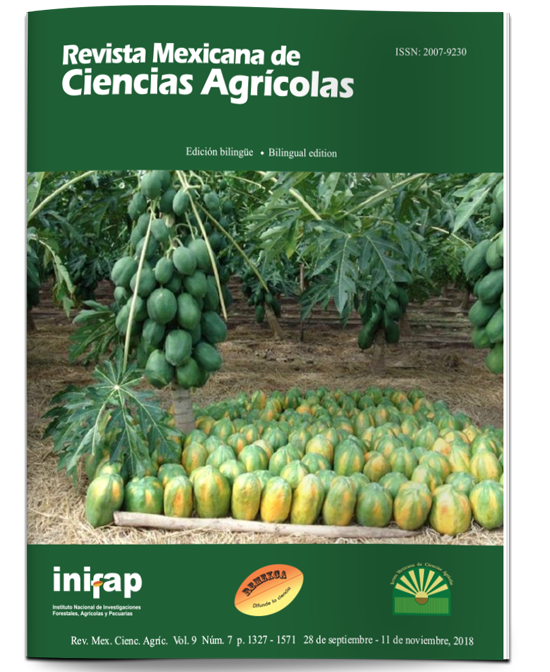Performance of white grain corn hybrids in five locations in High Valleys de México
DOI:
https://doi.org/10.29312/remexca.v9i7.1357Keywords:
Zea mays L., environment, male sterility, genetic improvementAbstract
Given the insufficiency in corn production, which translates into the import of up to 15 million tons of grain, it is urgent to increase the productivity of this crop, using more and better varieties. The objective of this work was to determine the agronomic characteristics of white hybrids in five different environments, the best response, as well as to define the effect of genotype × environment interaction on yield, and other characteristics evaluated for the High Valleys of Mexico (2 200 at 2 600 meters above sea level). In the spring-summer 2016 agricultural cycle, ten maize hybrids were evaluated in five locations using an experimental design of randomized complete blocks, with four repetitions. The analysis was factorial considering as factors the environments (5), the hybrids (10), as well as the environment × hybrid interaction. Eight agronomic variables were evaluated. Anovas and comparisons of Tukey means p= 0.05 were performed. Both factors presented differential responses and the variables evaluated were influenced by the effect of the environment. The hybrids with the highest average productivity were ATZIRI PUMA (12 t ha-1) and TSIRI PUMA (11.8 t ha-1) followed by the hybrids H-50, H-66 and H-70, which produced 11.5, 11.6 and 11.6 t ha-1 respectively. Considering that H-50 is one of the hybrids of greater commercial use in the High Valleys, the four referred hybrids of greater yield of white grain, could have perspectives of commercial use, in the environments managed in this study.
Downloads
Downloads
Published
How to Cite
Issue
Section
License
The authors who publish in Revista Mexicana de Ciencias Agrícolas accept the following conditions:
In accordance with copyright laws, Revista Mexicana de Ciencias Agrícolas recognizes and respects the authors’ moral right and ownership of property rights which will be transferred to the journal for dissemination in open access. Invariably, all the authors have to sign a letter of transfer of property rights and of originality of the article to Instituto Nacional de Investigaciones Forestales, Agrícolas y Pecuarias (INIFAP) [National Institute of Forestry, Agricultural and Livestock Research]. The author(s) must pay a fee for the reception of articles before proceeding to editorial review.
All the texts published by Revista Mexicana de Ciencias Agrícolas —with no exception— are distributed under a Creative Commons License Attribution-NonCommercial 4.0 International (CC BY-NC 4.0), which allows third parties to use the publication as long as the work’s authorship and its first publication in this journal are mentioned.
The author(s) can enter into independent and additional contractual agreements for the nonexclusive distribution of the version of the article published in Revista Mexicana de Ciencias Agrícolas (for example include it into an institutional repository or publish it in a book) as long as it is clearly and explicitly indicated that the work was published for the first time in Revista Mexicana de Ciencias Agrícolas.
For all the above, the authors shall send the Letter-transfer of Property Rights for the first publication duly filled in and signed by the author(s). This form must be sent as a PDF file to: revista_atm@yahoo.com.mx; cienciasagricola@inifap.gob.mx; remexca2017@gmail.
This work is licensed under a Creative Commons Attribution-Noncommercial 4.0 International license.



